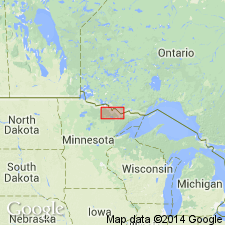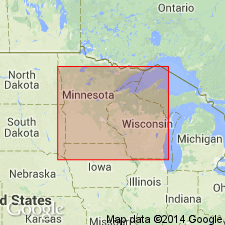
- Usage in publication:
-
- Vermilion Granitic Complex*
- Modifications:
-
- Revised
- Overview
- AAPG geologic province:
-
- Lake Superior region
Summary:
Revised in rank replacing informally designated Vermilion granite-migmatite massif of Southwick (1972). Includes, but not restricted to, the Vermilion Granite of Grout (1923) (no longer used) and to other abandoned names: Vermilion series, Vermilion schist, and Vermilion group, as used by Winchell and Winchell (1887) and Van Hise and Clements (1901). Is present in an area north of Vermilion district in northeastern MN, in Lake Superior region. Consists of Lac La Croix Granite (new), granite- and schist-rich migmatite, quartz-feldspar gneiss, hornblende quartz diorite and diorite, granodiorite and trondhjemite, amphibolite and amphibolite migmatite, older migmatite, biotite schist, Burntside Gneiss (adopted), and pegmatite. Geologic map and diagram of lithologic interrelationships. Is Archean in age.
Source: GNU records (USGS DDS-6; Denver GNULEX).

- Usage in publication:
-
- Vermilion Granitic Complex*
- Modifications:
-
- Overview
- AAPG geologic province:
-
- Lake Superior region
Summary:
Is part of the greenstone-granite terrane forming the southern part of the Superior province of the Canadian Shield in northern MN in the Lake Superior region. Interior part consists entirely of Lac La Croix Granite; however most of complex consists of biotite schist and amphibolite, metamorphosed generally to upper greenschist facies and near intrusives, to upper amphibolite facies. Gneisses have a complex history of injection, anatexis, metasomatism, and deformation. Correlation chart. Is assigned to the Late Archean.
Source: GNU records (USGS DDS-6; Denver GNULEX).
For more information, please contact Nancy Stamm, Geologic Names Committee Secretary.
Asterisk (*) indicates published by U.S. Geological Survey authors.
"No current usage" (†) implies that a name has been abandoned or has fallen into disuse. Former usage and, if known, replacement name given in parentheses ( ).
Slash (/) indicates name conflicts with nomenclatural guidelines (CSN, 1933; ACSN, 1961, 1970; NACSN, 1983, 2005, 2021). May be explained within brackets ([ ]).

